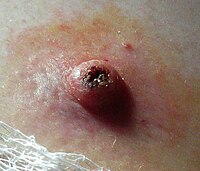
Photo from wikipedia
pletely destroyed producing a striking deformity and facies (Fig. 1). Based on clinical findings, the possibility of lupus vulgaris and discoid lupus erythematosus was kept. Hematological and biochemical investigations were… Click to show full abstract
pletely destroyed producing a striking deformity and facies (Fig. 1). Based on clinical findings, the possibility of lupus vulgaris and discoid lupus erythematosus was kept. Hematological and biochemical investigations were significant for raised erythrocyte sedimentation rate. Chest x-ray was normal. Mantoux test was positive with an induration of 21 9 18 mm at 48 hours. A skin punch biopsy taken from one of the plaques showed features of lupus vulgaris (Fig. 2). The patient was started on antitubercular treatment. Lupus vulgaris is a chronic, progressive paucibacillary form of cutaneous tuberculosis with varied clinical presentation. In India, the buttocks and trunk are commonly affected with nose being rarely involved. Classical clinical presentation is brownish red papules or nodules which slowly extend in some areas and heal with scarring in others. The ulcerative variant of lupus vulgaris involves deeper tissues causing destruction of cartilage producing contractures and deformities. Lesions over the face are more likely to heal with severe scarring, leaving behind a permanent stigmata of the disease which leads to social alienation. Timely diagnosis and treatment in such cases can save the patient from undue treatment, prolonged morbidity, and poor quality of life.
Journal Title: International Journal of Dermatology
Year Published: 2019
Link to full text (if available)
Share on Social Media: Sign Up to like & get
recommendations!